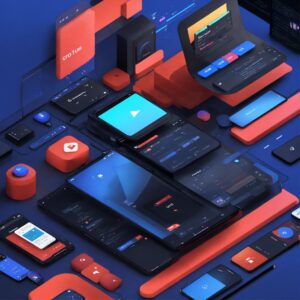UI/UX Design
We are a team of skilled professionals dedicated to helping businesses succeed in the digital world. The UI/UX design process is a series of steps taken to design and develop user interfaces and user experiences that are intuitive, efficient, and satisfying for users

UI/UX Design Process
The UI/UX design process is a series of steps taken to design and develop user interfaces and user experiences that are intuitive, efficient, and satisfying for users. The process typically includes the following steps: Research, Planning, Design, Development, Testing, Iteration, Launch
Best Quality
Support
money back
guarantee
affordable
price
Case Study
A UI/UX design case study is a detailed examination
of the design process and outcome of a particular
user interface or user experience project. It typically
includes information on the problem being solved,
the design process and decisions made, the final
design solution, and any results or feedback from
users.
fAQ
frequently asked questions
A user interface (UI) is the part of a website, application, or device you interact with. It includes screens, buttons, toggles, icons, navigation menus, and other visual elements. User experience (UX) refers to your entire interaction with a product, including how you feel about the interaction.
The design process can vary depending on the project and the designer, but it typically includes research, wireframing,
prototyping, and testing. It is important to understand the process to have a better understanding of the timeline and milestones.
We welcome feedback as a vital part of creating the best design. Our process includes structured feedback rounds at key milestones, where we encourage clear and specific input. We then iterate on the design based on your comments, ensuring open communication throughout. Our goal is to collaborate effectively to achieve a final product that aligns perfectly with your vision and project objectives.
Accessibility is a fundamental principle in our design work. We adhere to Web Content Accessibility Guidelines (WCAG) to create inclusive experiences. This involves careful attention to color contrast, keyboard navigation, legible typography, and semantic structure for screen readers. We strive to ensure our designs can be easily used and understood by people of all abilities.
We prioritize a mobile-first or responsive design approach, recognizing the importance of mobile users. This means designs adapt seamlessly across all screen sizes, from smartphones to desktops. We focus on touch-friendly interactions, optimized performance for mobile networks, and a clear hierarchy of content to ensure an excellent user experience on any device.
We achieve design consistency through the use of comprehensive design systems or style guides. These documents define UI components, typography, colors, and spacing, acting as a single source of truth. By designing with reusable components and testing across various browsers and devices, we ensure a cohesive and predictable user experience everywhere.
Continuous learning is key in our field. We stay updated by actively following industry publications, engaging with design communities, and participating in relevant courses or workshops. We also explore new tools and methodologies through experimentation. This commitment to learning allows us to apply fresh insights and best practices to your projects.
